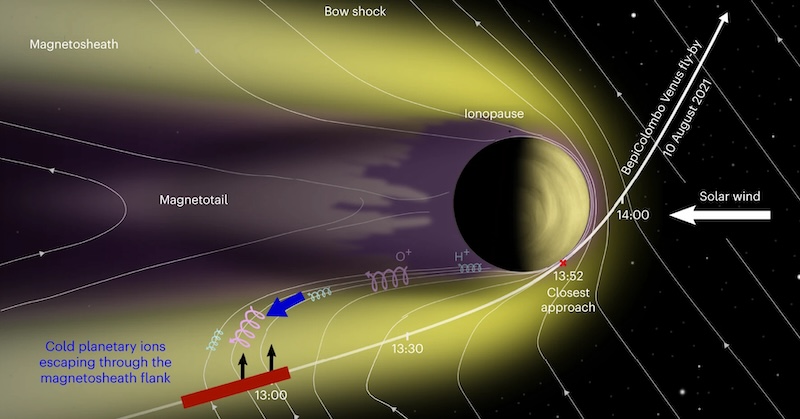- Carbon and oxygen ions are escaping Venus’ atmosphere into space. Scientists made the discovery when studying a previously unexplored region of Venus’ magnetosphere.
- The ESA and JAXA spacecraft BepiColombo analyzed this region during a Venus flyby. BepiColombo is en route to the planet Mercury.
- The findings also provide clues about the history of water escaping from Venus’ atmosphere over billions of years.
Venus’ atmosphere is leaking into space
Earth’s closest planetary neighbor, Venus – famous for its thick, noxious atmosphere – is leaking part of that atmosphere into space. That’s what a team of scientists from France, Germany, Austria and Japan said on April 12, 2024. BepiColombo, a mission of the European Space Agency (ESA) and Japan’s JAXA, made two flybys of Venus on its journey to Mercury. The spacecraft found carbon and oxygen escaping into space in a previously unexplored region of Venus’ magnetosphere. These gases are somehow being stripped away from the atmosphere’s upper layers.
The researchers published the peer-reviewed results of the Venus atmosphere analysis on April 12, 2024, in the journal Nature Astronomy.
Attention astronomy enthusiasts! Are you looking for a way to show your support for astronomy education? Donate to EarthSky.org here and help us bring knowledge of the night sky and our universe to people worldwide.
Escape from Venus’ atmosphere
BepiColombo’s visit to Venus on August 10, 2021, was brief, but it yielded important new information about the planet’s atmosphere. In fact, during this second flyby, the spacecraft studied a previously unexplored region of Venus’ magnetosphere. Basically, the magnetosphere is the region around a planet dominated by the magnetic field. And, if you could see it, it would look like a huge bubble around the planet. Magnetospheres aren’t always round, though. In fact, Earth’s magnetosphere is comet-shaped.
So, it was in an area of Venus’ magnetosphere that hadn’t been studied closely before that scientists found evidence of carbon and oxygen ions escaping from the planet’s upper atmosphere. An ion is an atom or group of atoms that bears one or more positive or negative electrical charges. Lina Hadid is a researcher at the National Centre for Scientific Research (CNRS) and the The Laboratory of Plasma Physics (LPP) in France and lead author of the study. She said:
This is the first time positively charged carbon ions have been observed escaping from Venus’ atmosphere. These are heavy ions that are usually slow moving, so we are still trying to understand the mechanisms that are at play. It may be that an electrostatic ‘wind’ is lifting them away from the planet, or they could be accelerated through centrifugal processes.
A weak magnetosphere
In general, Venus is rocky and of similar size and mass to Earth. Unlike Earth, however, it lacks a powerful magnetic field generated in its core. But it does have a magnetic field and magnetosphere, albeit much weaker than Earth’s. Scientists call it an induced magnetosphere. In Venus’ case, charged particles from the sun interact with the planet’s upper atmosphere to create the magnetosphere. In addition, a region of magnetic turbulence, called the magnetosheath, surrounds this weak magnetosphere. Overall, this has the effect of slowing down and heating the solar wind from the sun, which contains the charged particles.

The history of Venus’ atmosphere
BepiColombo used its Mass Spectrum Analyzer (MSA) and Mercury Ion Analyzer (MIA) to examine Venus’ magnetosphere. Both sensors are part of the Mercury Plasma Particle Experiment (MPPE) instrument package on Mio, the JAXA-led Mercury Magnetospheric Orbiter. The new data help scientists better understand the history of Venus’ atmosphere. Dominique Delcourt, a researcher at LPP and the Principal Investigator of the MSA instrument, said:
Characterizing the loss of heavy ions and understanding the escape mechanisms at Venus is crucial to understand how the planet’s atmosphere has evolved and how it has lost all its water.
In addition, scientists used Europlanet Society’s Sun Planet Interactions Digital Environment on Request (SPIDER) tools to track the carbon and oxygen ions as they escaped Venus’ atmosphere and moved through the magnetosheath. As Nicolas André of the Institute for Research in Astrophysics and Planetology (IRAP) and leader of the SPIDER service noted:
This result shows the unique results that can come out of measurements made during planetary flybys, where the spacecraft may move through regions generally unreachable by orbiting spacecraft.
Water loss in Venus’ atmosphere
These results also have implications for the loss of water from Venus’ atmosphere over billions of years. Many scientists, in fact, think Venus likely once had oceans. With this in mind, co-author Moa Persson at the Swedish Institute of Space Physics added:
Recent results suggest that the atmospheric escape from Venus cannot fully explain the loss of its historical water content. This study is an important step to uncover the truth about the historical evolution of the Venusian atmosphere, and upcoming missions will help fill in many gaps.
Bottom line: The BepiColombo spacecraft, headed for Mercury, flew past Venus and found that carbon and oxygen ions are escaping into space from Venus’ atmosphere.
Source: BepiColombo observations of cold oxygen and carbon ions in the flank of the induced magnetosphere of Venus
Via Europlanet Society
Read more: Amino acids on Venus? New study says it’s possible
Read more: Surprise! Plate tectonics helped create Venus’ hellscape